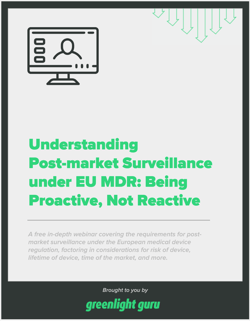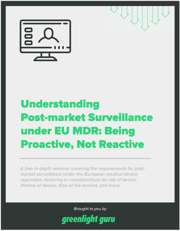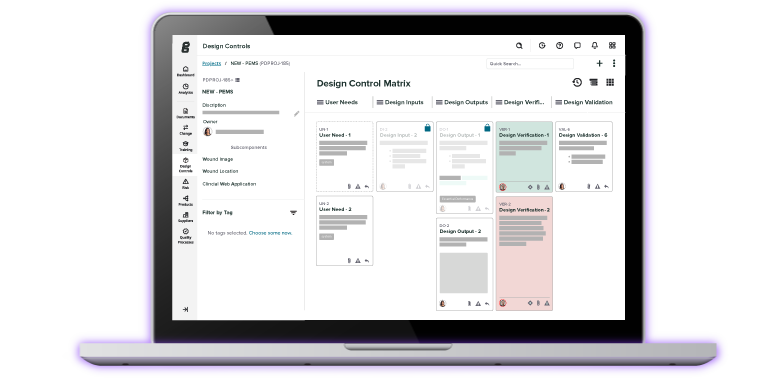5 Postmarket Surveillance System Musts for Every EU Manufacturer

Designing, developing, and getting your medical device approved and onto the market is a huge accomplishment—but it isn’t the end of your responsibilities.
For the EU market, the European Commission (EC) requires manufacturers to perform ongoing postmarket surveillance (PMS) activities once a device is placed on the market. This surveillance monitors for any potential safety or efficacy issues with the device, but it also allows manufacturers to be proactive when it comes to protecting patients.
By gathering customer feedback and other PMS data, manufacturers have an opportunity to proactively make improvements to their product or processes and prevent issues from arising in the first place.
The details of each PMS system may differ slightly from company to company, but if you plan on selling your medical device in the EU, your system must include these five components:
1. Postmarket surveillance plan
A postmarket surveillance plan is a systematic process that is designed for the monitoring of a specific device. Note that each individual device requires its own PMS plan. Though the plans for different devices may have a lot of similarities, you cannot simply reuse a PMS plan from one device to another.
Your PMS plan must define which data should be surveilled, how it should be collected, and how you will investigate or determine reportable trends.
The type of data collected will vary depending on the product, but a postmarket surveillance plan should always include:
-
Investigations of both serious and non-serious incidents
-
Reports of undesirable side effects
-
Analysis of trends
-
Feedback from users, distributors, or importers—including complaints
-
Publicly available information about similar devices, as well as relevant information from literature, databases, or other sources.
In addition, the PMS plan must also address the processes used to collect this data and the methods used to assess the collected data. This means you will need to include the methods, protocols, or tools used for activities such as:
-
Investigating complaints and other market feedback
-
Identifying and analyzing reportable trends
-
Identifying and initiating corrective actions
-
Tracing and identifying devices that require corrective action
Your PMS plan enables better monitoring for any adverse events as well as gathering data on the long-term safety and effectiveness of the device. This is vital information that will help you gather meaningful feedback from end users, discover data trends, and make informed decisions on any updates or iterations to your product.
2. Postmarket surveillance procedures & protocols
Postmarket surveillance is only as good as the standard operating procedure (SOP) you put in place to organize and manage the data that is collected.
Your postmarket surveillance system should have an SOP that includes:
-
Activity triggers. These are usually either time-based (“We do X every quarter.”) or prompted by a specific activity (a customer call, shipping the 5000th unit, publishing a new procedure or amendment to a procedure, etc.
-
A list of information sources. This might include customer feedback, service reports, employee observations, clinical follow-up studies, assessment results and any other source of good information.
-
Your PMS activities. These might include things like collecting, analyzing, and evaluating data before taking action on it.
-
The roles and responsibilities for PMS activities. You must indicate exactly who is responsible for what within your PMS system. Use specifics when describing the activities assigned to each role.
-
Documentation of PMS plan and activities. Not only does your PMS plan have to be documented, you also need to provide evidence of the various activities that show you’re following the plan you laid out.
Huge amounts of actionable data are generated when a medical device goes to market. Without a strong SOP in place, you risk losing out on the insights that data holds for patients and providers.
3. Evidence of postmarket surveillance activities
Creating your PMS plan and establishing a well-structured SOP is an excellent start to building a strong postmarket surveillance system for your medical device.
But unless you have documented evidence that you’ve been conducting the surveillance activities according to your PMS plan, all that work is for naught. From a regulator’s point of view, if it wasn’t documented, it didn’t happen.
At minimum, your postmarket surveillance system should include formal documentation of:
-
How you collect the information from your data sources
-
Your methodology for assessing data
-
The rationale used for risk analysis
-
Your methods for receiving and investigating complaints
-
Your methods for determining trends
-
Procedures for communicating with authorities where needed
-
Device tracing methods
-
Any actions you have taken as a result of PMS
Postmarket surveillance generates a lot of documents and demands a system that has the capabilities to store and manage that data. Greenlight Guru’s quality management software does more than just streamline and automate PMS processes.
Greenlight Guru Quality offers a secure solution for manufacturers to maintain the integrity of documents stored within a dedicated PMS system, simplifying compliance requirements from whichever market you sell your devices.
4. Postmarket surveillance report (PMSR) & periodic safety update report (PSUR)
If you’re manufacturing a Class I device in Europe, you’re required under MDR to create a Postmarket Surveillance Report (PMSR). The purpose of a PMSR is to provide a summary of the results and conclusions of your PMS data, as well as a rationale and description of any corrective actions you took as a result of PMS activities.
For Class IIa, IIb, and III devices, the MDR requires a Periodic Safety Update Report (PSUR), which is an extension of the PMSR. The PSUR should contain a summary of your PMS results and conclusions as well as a summary of postmarket information, vigilance reporting, and the current status of the device on the market.
Finally, your PSUR must include the rationale for any corrective or preventive actions you took, such as:
-
Conclusions of your risk-benefit determination
-
Main findings of your postmarket clinical follow-up
-
Sales volume of the device
-
Estimates of the size of other characteristics of the audience using the device (plus usage frequency if known).
Keep in mind, while the PMSR and PSUR may seem exhaustive, there’s still one more form of postmarket surveillance that your device may require.
5. Postmarket clinical follow-up (PMCF) & feedback system
Postmarket clinical follow-up (PMCF) is a proactive form of surveillance that systematically gathers clinical data on how the device is used and the outcomes of that use. It is concerned with ensuring the real-world use of a device is accurately characterized.
PMCF isn’t always necessary, but its absence must be justified in your PMS plan. All high-risk devices require postmarket clinical follow-up, and some low or moderate-risk devices may have residual risks that could benefit from a PMCF.
MEDDEV 2.12-2 Rev. 2 suggests PMCF may be needed under the following circumstances:
-
Novel medical technology
-
High product-related risk
-
High-risk anatomical locations
-
High-risk target populations (e.g. children, elderly)
-
Severity of disease/treatment challenges
-
Unanswered questions of long-term safety and performance
-
Identification of previously unstudied subpopulations which may exhibit different benefit/risk-ratio (i.e. hip implants in different ethnic populations)
-
Verification of safety and performance of the device when exposed to a larger or a more varied population of clinical users
All PMCF studies should include:
-
Clearly stated objective(s)
-
Scientifically sound design with an appropriate rationale
-
Logical study plan and implementation
-
Appropriate statistical analysis of data, interpretation, and conclusion
PMCF is simply an extra layer of protection for devices that require heightened postmarket surveillance. It may take more time, but your patients and your stakeholders will be glad to know it’s happening.
Streamline & automate your postmarket surveillance
Postmarket surveillance is a critical part of ensuring the safety and efficacy of your medical device, but it requires the ability to collect and manage a tremendous amount of data and documents.
With Greenlight Guru’s Document Management solution, you get more than just a place to store your data. You get a secure solution for storing documents that offers seamless visibility and traceability for all your postmarket data.
If you need a streamlined, medical device-specific solution for managing your postmarket surveillance system, Greenlight Guru has you covered. Get your free demo today →
Looking for a design control solution to help you bring safer medical devices to market faster with less risk? Click here to take a quick tour of Greenlight Guru's Medical Device QMS software
Sara Adams has spent over 15 years helping MedTech companies prepare for FDA inspections and build strong quality systems. Her expertise spans startups and established organizations, where she has led teams through high-stakes audits, simplified compliance, and improved operations. Sara is skilled in Quality System...
Related Posts
Creating a Periodic Safety Update Report (PSUR) that Complies with MDR & IVDR
Change Management Process Explained in 6 Easy Steps (+ free template)
Quality Management Plan - How to Create Yours (Tips & Best Practices)
Get your free resource
Understanding Post-market Surveillance under EU MDR: Being Proactive, Not Reactive










